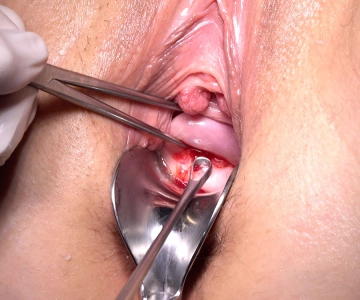The positioning of the patient during hysteroscopy is in the lithotomy position using leg holders. The patient lies on her back, and her legs are bent at the hip joints approximately 90°. The knees are also significantly bent. The lower legs are positioned on the leg holders so that the legs are slightly spread apart. This arrangement allows optimal access to the vaginal and uterine area for the procedure.
-
Positioning
-
Disinfection and single-use catheterization
-
Anesthesia examination
Soundsettings The bimanual palpation is performed after disinfection or shortly before (ensure sterility). One hand remains in the vagina while the other is placed on the lower abdominal wall. With the vaginal hand, the uterus and adnexa are gently pressed against the abdominal wall. The external hand acts as a counterbalance and provides the palpation findings. For the examination of the adnexa, the vaginal vault is lifted laterally. This is important to assess the position and size of the uterus.
The Scherback speculum is available in various designs with different blades and rims. By attaching a weight to the lower blade, it becomes a self-retaining speculum. Examination with this instrument allows for the observation of the entire vagina up to the posterior vaginal vault and the cervix.
-
Cervical curettage
![Cervical curettage]()
Soundsettings In a fractional curettage, the cervical curettage is performed first. Grasp the anterior lip of the cervix at approximately 11 o'clock with a tenaculum (Schröder's hook forceps). Under continuous traction on the tenaculum, tissue is removed from the cervical canal with a fine, sharp curette that can pass through the external os.
-
Determination of the probe length
Soundsettings A special measuring probe is used to determine the length of the uterus. This probe consists of a handle and a long, curved, scaled probe with a small globe at its end.
Insertion of the probe: The measuring probe is carefully inserted through the cervical canal into the uterine cavity. The curved shape of the probe facilitates insertion and navigation through the canal.
Determination of length: Once the globe at the end of the probe reaches the fundus region of the uterus, the length of the uterus can be read from the scale on the probe.
Determination of instrument depth: Based on the determined uterine length, it is established how far the curettes may be inserted during the curettage.
This measuring process is important to know the exact length of the uterus and thus minimize the risk of injury during curettage.
Before curettes can be introduced into the uterus for scraping, the cervix must be dilated. This is
Activate now and continue learning straight away.
Single Access
Activation of this course for 3 days.
Most popular offer
webop - Savings Flex
Combine our learning modules flexibly and save up to 50%.
US$51.56/ yearly payment
gynecology
Unlock all courses in this module.
US$103.10 / yearly payment


